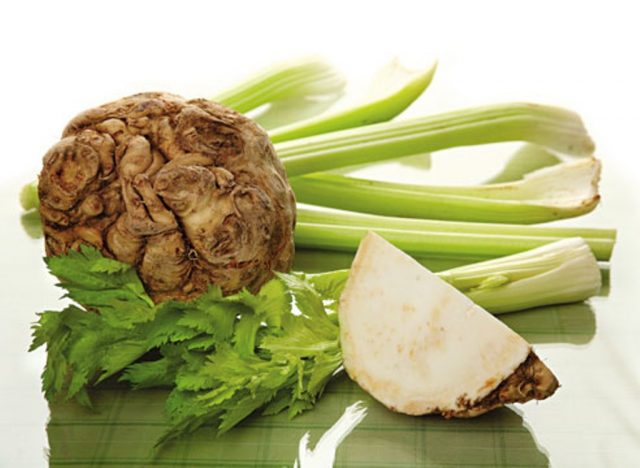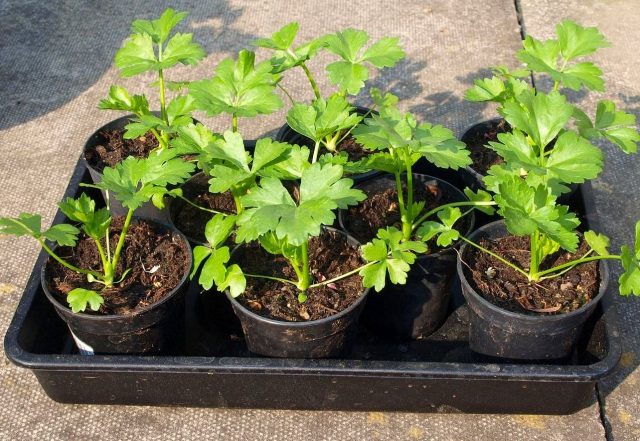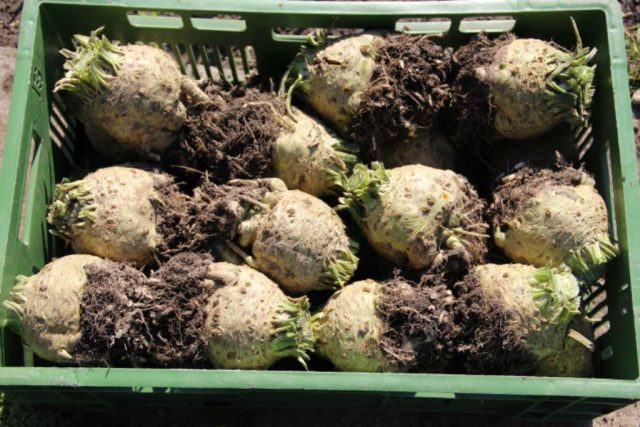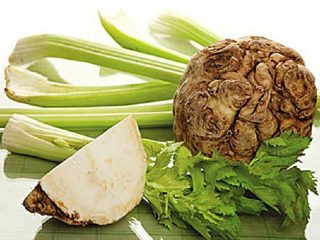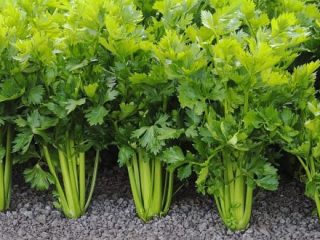Content
Root celery is a healthy vegetable with a high content of vitamins and microelements. To obtain greens and root vegetables, the plant is grown as an annual plant, and to obtain seeds - as a biennial plant. It is not difficult to grow, since caring for root celery in open ground is simple and even a novice gardener can handle it.
Methods for growing celery root
It is possible to grow large root celery only through seedlings, since the plant has a long growing season. If the seeds are sown in open ground, they will sprout, but even the early varieties will not have time to produce a harvest. Therefore, seeds are sown for seedlings at the end of winter.
The most high-yielding and popular varieties of root celery:
- Apple – from germination of seedlings to digging up root crops – 150 days. Root celery grows large, weighing about 200 g. Juicy greens and snow-white pulp are used for food.
- Gribovsky – mid-season variety with large rounded root crops. The pulp is aromatic, with good taste. Ripening occurs after 190 days. The variety is easy to care for and has a long shelf life.
- Diamond – mid-early, high-yielding variety. The vegetable grows large, reaching 0.5 kg. The snow-white, aromatic pulp can be tasted already in early August. The harvest is well transported and stored.
- Esaul – early ripening, unpretentious variety. From the emergence of seedlings to the collection of juicy, snow-white pulp, about 150 days pass.
- Egor – a mid-season variety with round, elongated fruits weighing up to 600 g. The snow-white pulp is aromatic with a high sugar content.
Root celery of the Russian size variety is one of the most popular. Since the root crop reaches 2.5 kg at full maturity. The juicy, snow-white pulp has a nutty taste. The variety is easy to care for and grows well in fertile soil. The vegetable is used as a healthy independent dish or aromatic seasoning.
How to Grow Root Celery from Seeds
Root celery can only be grown in open ground through seedlings. To do this, you need to choose the right seed, planting container and nutrient soil.
When to sow celery root for seedlings
For high fruiting, it is necessary to sow the seeds for seedlings in a timely manner. Sowing can begin in early February, since young seedlings do not stretch and do not need additional lighting.But if you are late with sowing, the harvest will be meager or will not have time to ripen. For the Central and Northwestern regions of Russia, early varieties of root celery are suitable. In regions with warm and long summers, both early and late varieties of root celery can be planted.
Selection of planting container and soil preparation
Any container is suitable for growing seedlings: boxes, plastic or peat cups, containers or special cassettes. Before sowing the seeds, scald the container with boiling water.
The earth mixture can be purchased at the store or mixed yourself. To prepare nutritious soil, you need to mix turf soil, peat, humus, and mullein in a ratio of 1:6:2:1. You can also mix vermicompost and river sand 1:1. Properly prepared soil is light, loose, homogeneous and nutritious.
Seed preparation
It is better to purchase celery root seeds in a specialized store. When purchasing, you need to check the expiration date, since germination lasts 2-3 years.
Since the seed contains a high content of essential oils, it must be processed before sowing. To do this, the seeds are wrapped in gauze and placed in water at room temperature. The water must be renewed 6 times every 4 hours.
You can also carry out pre-sowing germination. To do this, cover the saucer with a damp cloth, distribute the seeds on top, and put the container in a warm room. During the germination process, the tissue must be constantly moistened.
Planting root celery for seedlings
Fruiting and taste depend on properly grown seedlings. Seeds can be sown in 2 ways:
- Traditional. The container is filled with nutritious, moist soil. If sowing is done in a box, then furrows are made with a toothpick at a distance of 3 cm. The treated seeds are distributed in the grooves according to a 2x2 pattern. The seeds are sprinkled with earth, covered with polyethylene or glass and placed in a well-lit, warm place.
- Under the snow. Make grooves 7 mm wide in the ground and fill them with snow along the entire length. The crops are covered with glass and put in a warm place. The good thing about this method is that you can place the seeds at the proper distance on a white background. Also, when the snow melts, the seeds will sink to the optimal depth, and the melt water will speed up germination.
Pre-soaked seeds will germinate in 10 days, dry seeds will take 2 times longer.
Seedling care
Caring for seedlings is not difficult. For growth and development, it is necessary to maintain temperature and humidity conditions. The optimal temperature for germination is + 18-22 °C. Until the sprouts appear, the soil is not irrigated, since the accumulated condensate will be enough to moisten the soil.
After the emergence of seedlings, the shelter is removed and the container is transferred to the brightest place. Since there are short daylight hours in winter, most gardeners provide additional lighting for seedlings. But strong seedlings can be grown without additional light, since root celery is not prone to stretching when grown.
After 2-3 sheets appear, the first picking is carried out. Second time at one month of age. In each case, when transplanting seedlings into a larger pot, the root system is shortened by 1/3 of the length.
In April, properly grown seedlings should grow in pots with a diameter of 10 cm.At this time, they begin to harden it, take it out into the open air, increasing the stay time daily. Watering the seedlings is carried out as the soil dries out, since excessive irrigation can lead to the appearance of blackleg.
How to grow root celery in open ground
Root celery is unpretentious in cultivation and care. With the right choice of variety and compliance with agrotechnical rules, even a novice gardener can grow the vegetable.
Timing for planting root celery in the ground
Celery is planted in a permanent place at the age of 70-80 days. Since the plant is not frost-resistant and can die in unheated soil, there is no need to rush with planting. The optimal soil temperature should be + 10 °C and above. There are no specific planting dates; it all depends on the region and climatic conditions. Seedlings can be planted under the film in mid or early May. If you are late with planting, the root celery will outgrow and bring a meager harvest.
Selection and preparation of a landing site
The area for root celery should be in a well-lit place. On swampy soil and with close groundwater, seedlings are planted in high beds, since increased soil moisture leads to the death of the plant. Celery root will grow best on:
- loamy soil with a high content of humus;
- cultivated peat bog;
- fertile lowland soil.
Optimal predecessors will be potatoes and all types of cabbage. Beds for celery can be made in the neighborhood where onions, cucumbers, lettuce, and beets will grow.Tomatoes, potatoes, and legumes will be bad neighbors.
Planting root celery in open ground
Since root celery during growth forms a powerful leaf rosette and a large root crop, the distance between plantings should not be less than 30-40 cm, between rows - 70 cm.
The prepared well is spilled, 1 tbsp is added. l. wood ash and plant seedlings. The plant is carefully sprinkled with earth, the top layer is compacted. To ensure that there are no air voids left between the roots, the planting is watered generously. After irrigation, the surface is sprinkled with dry soil and mulched.
To quickly adapt, seedlings are planted in cloudy, windless weather. After planting, the bed is covered with covering material to protect it from spring frosts.
Root celery is grown according to all agrotechnical rules. Care consists of weeding, loosening, watering and fertilizing.
How to feed celery and how to water it
Root celery is a moisture-loving plant. Therefore, it needs regular, abundant watering. Irrigation is carried out after planting seedlings and before harvesting. The main rule in care is to prevent the soil from drying out and becoming waterlogged. As a rule, watering is carried out once every 2-3 days, early in the morning or late in the evening.
At the stage of growing green mass, the plant needs nitrogen, during the formation of root crops - in potassium, for better ripening - in phosphorus. The first fertilizing is applied 2 weeks after planting the seedlings.To do this, you can use green fertilizer made from nettles. Ash infusion is used as a potassium-phosphorus supplement.
Weeding and loosening
After each watering, the soil must be loosened, as this is an important point in care. This procedure will allow air to penetrate into the lower layer of soil, which will lead to better formation of the root system.
It is not recommended to hill up root celery, since the earthen embankment leads to a decrease in yield. On the contrary, as the root crop grows, the soil is raked away from the plant. With this approach, the root crop grows large and of regular shape.
Weeding is needed regularly, since weeds are carriers of diseases, and they limit the growth of celery.
Cleaning up excess leaves and roots
Celery root has edible and fleshy, juicy leaves. But when cutting off green mass en masse, it can harm the taste of the vegetable. Therefore, you can cut only 1-2 leaves daily. It is better to remove the lowermost leaves.
How to grow celery root without a beard
Planting and caring for root celery is not difficult, but often when harvesting, gardeners observe a large number of small roots on the root crop.
In order for the vegetable to look attractive, grow large, juicy and aromatic, it is necessary to remove excess soil as it grows. During the process of care, you can find a large number of small lateral roots. They must be removed, as they not only spoil the presentation, but also suck all the nutrients from the vegetable, making it less juicy.
Protection from diseases and pests
With proper care, celery root rarely suffers from diseases. But there are times when insect pests or various diseases appear on the plant. This is due to non-compliance with crop rotation and the wrong choice of neighbors. Most often the following appear on the plant:
- Cucumber mosaic – The disease can be recognized by the appearance of the foliage. Spots and yellow rings appear on it, between which a mesh pattern appears. The main carriers are aphids, wind, and raindrops.
- Septoria – the leaves are covered with small round spots. As a result, the leaf plate curls and dries out. The disease often progresses in spring and autumn in cloudy rainy weather.
- White rot – in the initial stage of the disease, the fungus attacks the foliage and, without treatment, immediately moves to the root crop, thereby destroying the crop. It is impossible to get rid of the disease, so the infected plant must be removed in a timely manner so that the disease does not spread to neighboring crops.
- Celery fly – with the onset of warm days, lays eggs on the plant. The hatched larvae feed on the sap of the stem and root crop. Without treatment, the plant weakens and may die.
To prevent mass infection, you must follow simple rules of care:
- treat the seeds before planting;
- regularly loosen the soil and remove weeds;
- observe crop rotation;
- When the first signs of disease appear, carry out treatment: against insect pests - with insecticides, against diseases - with fungicides.
Harvesting
The time to harvest celery root depends on the variety and climatic conditions.Early ripening varieties begin to be harvested in early September, late ripening varieties - in early October. Timely care is responsible for quality and quantity.
The collection time is determined by the yellowed foliage. But do not rush to harvest, as a ripe vegetable can withstand minor frosts. A ripe crop can be easily pulled out of the garden, but when harvesting, you can use a fork, being careful not to cause mechanical damage.
After harvesting, the vegetables are inspected, the foliage is cut off, the soil is cleared and left to dry. After drying, they are laid out in prepared containers and stored for long-term storage. If the root celery is planned to be eaten immediately, it is placed in a plastic bag and placed in the refrigerator. For long-term storage, celery is placed in a cellar, where the air temperature does not rise above + 1 °C.
Is it possible to leave root celery over winter?
Gardeners often grow root celery as a biennial plant. In the second year, the plant produces an arrow on which seeds are formed. Caring for celery consists of watering, loosening and weeding. At the end of August, seeds ripen on the plant, which are stored in paper bags in a dry, dark place until planting.
What to plant after celery root
Every gardener knows how important it is to observe crop rotation. In the garden after growing root celery, the following will grow beautifully:
- cabbage;
- cucumbers;
- onion;
- legumes;
- strawberries;
- grape.
Carrots, tomatoes, herbs, but it is not recommended to grow radishes after celery, since the crops have similar diseases and insect pests.
Conclusion
Caring for root celery in open ground is not a difficult task; even a novice gardener can handle it. To obtain a rich harvest, it is necessary to carry out timely watering, fertilizing, loosening and weeding. Growing root celery is not only about obtaining a useful root crop, but also a very interesting, exciting activity that requires a minimum of effort and time.
